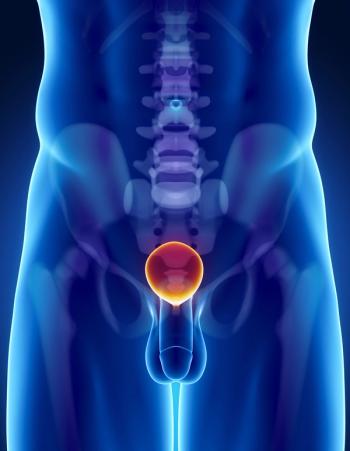
Oncology NEWS International
- Oncology NEWS International Vol 18 No 7
- Volume 18
- Issue 7
Should expectant management serve as the primary treatment option in prostate cancer?
Prostate cancer experts agree on one issue: No single treatment can be considered universal for men diagnosed with prostate cancer. There are myriad choices and considerations to be reviewed with every diagnosis. In addition, there are conflicting data about when, or if, men require screening for prostate cancer as well as when to start therapy for confirmed disease.
ABSTRACT: Current data suggest that expectant management offers a comparable survival to radical prostatectomy or radiotherapy in men with low-risk prostate cancer or a short life expectancy.
Prostate cancer experts agree on one issue: No single treatment can be considered universal for men diagnosed with prostate cancer. There are myriad choices and considerations to be reviewed with every diagnosis. In addition, there are conflicting data about when, or if, men require screening for prostate cancer as well as when to start therapy for confirmed disease.
“This is a complex and critical issue for us to discuss. Every 18 minutes, another man dies from prostate cancer in the United States,” said James L. Mohler, MD, chair of the department of urologic oncology at Roswell Park Cancer Institute in Buffalo, N.Y.
Prostate cancer is one of the most common cancers. According to the American Cancer Society, 218,890 men were diagnosed with prostate cancer in 2007, and there were 27,050 deaths from this disease. Over 90% of men are diagnosed at an early stage, and the five-year survival rate for men with localized disease is approaching 100%. Treatment choice will depend on the PSA level, tumor stage and grade, life expectancy, medical history, and likelihood of tumor progression. Dr. Mohler, along with his Roswell colleague, Michael Kuettel, MD, PhD, MBA, took turns outlining the benefits and risks of expectant treatment at the 2008 Oncology World Congress in San Francisco. Dr. Kuettel is the Barbara and George Hyde Professor and chair of radiation medicine.
Benefits and risks
“We can assure men that they have time to consider their options,” Dr. Kuettel said. “Prostate cancer is a disease where confirmation of the diagnosis can be more critical than rushing into treatment. Many men should consider expectant management and then carefully compare the benefits and risks of treatment against expectant management.” “The use of the PSA test, developed at Roswell Park, has allowed us to identify prostate cancers before they become clinically apparent. The death rate has decreased every year since 1992, which almost certainly results from earlier detection by PSA, but now we are coordinating cancer care for some men who may not have died or even suffered from their prostate cancer if they had not been diagnosed or, if diagnosed, been observed,” Dr. Mohler said.
Current data suggest that expectant management (also known as watchful waiting or active surveillance) has a survival rate comparable to the overall survival of men treated with either a radical prostatectomy or radiotherapy when prostate cancer is low risk at the time of diagnosis. The NCCN promotes expectant management as an option for men with low-risk cancers or a shorter life expectancy. Men who select this option must be willing to actively participate in regular monitoring of their cancer.
“For these men, any clinical change would result in further testing,” Dr. Mohler said. “Some men will see progression of their cancer, but most men will not. We cannot accurately predict at this time which men will progress versus which men will not. It may be that younger and healthier men need to be followed more closely, whereas older and less healthy men can be followed less frequently when they choose expectant management.”
In a study led by Laurence Klotz, MD, at the University of Toronto, 331 men (mean age 70), 80% of whom had a Gleason score ≤ 6 and mean PSA 6.5 ng/mL, were put under active surveillance. According to the results, 66% remained under follow up (mean of six years); 34% progressed to treatment. Of that 34%, 15% showed biochemical progression (PSADT < 3 years); 3% had clinical progression; 4%, histological progression; and, in 12%, treatment was performed based on patient preference. The overall survival was 85% and prostate-cancer-specific survival was 99% (J Natl Compr Cancer Netw 5:693-698, 2007).
Not the best option
In the past several months, prostate cancer screening has come under fire. First, the U.S. Preventive Services Task Force released new guidelines stating that prostate cancer screening should stop at age 75. Then, results from two major randomized trials, PLCO based in the U.S. and the ERSPC study in Europe, determined that PSA testing was, at best, ambiguous. At worst, it led to overdiagnosis (see Table on page 25).
“However, I am not sure that we can easily place an age for the end of prostate cancer screening or treatment,” Dr. Mohler explained. “I have known men at age 75 with a 20-year life expectancy and men at age 60 with only a five-year life expectancy. I think that we need to get better at determining how to identify the men for whom immediate treatment is necessary, and this requires accurate estimation of both life expectancy and the limitation to that life expectancy posed by prostate cancer.”
Prostate cancer treatment is very different now from a decade ago. For instance, modern radiation equipment allows physicians to better deliver higher doses of radiation to the tumor with significantly less radiation exposure to normal tissue. Minimally invasive surgery offers advantages such as a shorter hospital stay and faster recovery, less blood loss, less pain, and faster recovery of urinary control. Men have many therapeutic options to consider when it is determined that active treatment is needed.
However, treatment for prostate cancer is not without risk. Men have to be aware that they may suffer impotence or incontinence after therapy. These quality-of-life issues need to be weighed against the risk of delaying therapy.
In 2008, a Boston-based group surveyed 1,201 prostate cancer patients and 625 spouses or partners on their quality of life and satisfaction with outcomes. Treatment methods used were radical prostatectomy, brachytherapy, or external-beam radiotherapy.
According to the results, adjuvant hormone therapy was associated with worse outcomes across multiple quality-of-life domains among patients receiving brachytherapy or radiotherapy.
Patients in the brachytherapy group reported having long-lasting urinary irritation, bowel and sexual symptoms, and transient problems with vitality or hormonal function.
After prostatectomy, urinary incontinence was observed, but urinary irritation and obstruction improved, particularly in patients with large prostates. The authors found that treatment-related symptoms were exacerbated by obesity, a large prostate size, a high PSA score, and older age (N Engl J Med 358:1250-1261, 2008).
The NCCN guidelines point out that delay in starting therapy may lead to a missed opportunity for a cure, that cancer may metastasize, or that the growth of the tumor may complicate future treatment plans. An increase in the difficulty of nerve-sparing prostatectomy or more intense side effects due to the need to treat a larger tumor are among the potential complications.
“There have been studies that suggest that delay of treatment may lead to future treatment failure and thus a missed cure,” Dr. Kuettel continued. “However, this is not a short delay of a couple of months, but rather delays of six months or more. There is ample time to help a patient consider all of his choices before selecting a treatment plan.” Thus the best choice of “treatment” for many men with low-risk prostate cancer may be expectant management, but expectant management may not the best choice for many men. “When my patient cannot sleep at night for worry that his prostate cancer is spreading, he requires treatment although I can’t assure him that that treatment is necessary,” Dr. Mohler said.
Articles in this issue
over 16 years ago
Less is more when it comes to serial CA125 testing in ovarian cancerover 16 years ago
Treatment varies widely in chronic myeloid leukemiaover 16 years ago
Oncology takes blame for rising healthcare costover 16 years ago
NSABP chair admits ‘failure’ in C-08 trial, denies defeatover 16 years ago
Gemcitabine, capecitabine regimens equal in breast ca metsNewsletter
Stay up to date on recent advances in the multidisciplinary approach to cancer.

















































































